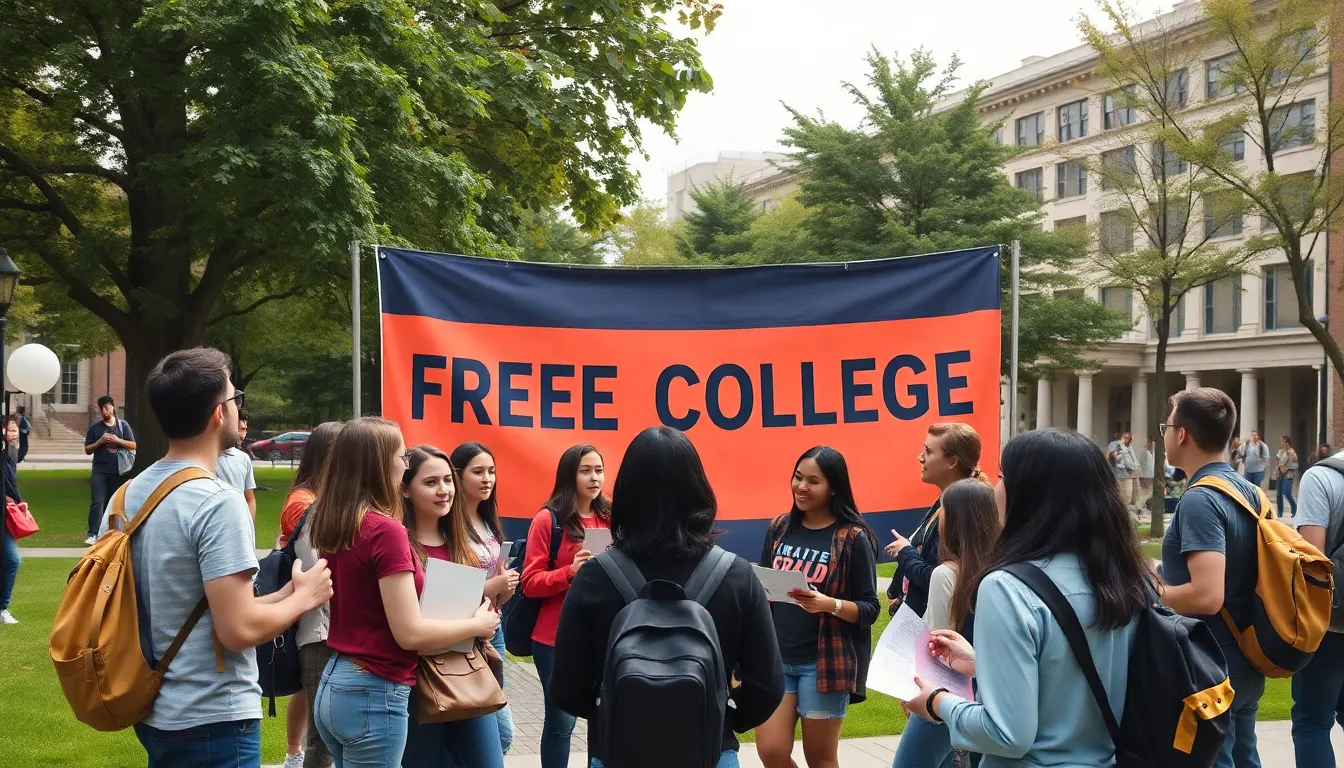Table of Contents
ToggleImagine a world where college tuition doesn’t send students into a financial tailspin. Sounds like a fantasy, right? But there was a time when higher education didn’t come with a hefty price tag. In fact, many countries embraced the idea of free college, believing that education should be a right, not a privilege.
Historical Overview of College Tuition
Higher education experienced periods of low or no tuition costs, particularly in the mid-20th century. During this time, many countries prioritized educational access. The establishment of programs like the G.I. Bill in the United States in 1944 offered significant support for veterans seeking college education, covering tuition and fees.
In Europe, countries such as Germany and Norway adopted policies providing free college education to all citizens. Governments believed education plays a crucial role in economic development. Various institutions, especially public universities, charged minimal fees, encouraging enrollment.
By the 1970s, tuition costs began to rise as government funding declined. Students faced mounting financial burdens, limiting access to education. In contrast, previous generations enjoyed affordable college options.
In countries with free education policies, students experienced less debt. Nations like Finland exemplified models where tuition remained free for both citizens and international students.
Recent discussions around free college education focus on restoring previous ideals. Advocacy groups emphasize the need for accessible education as a public good. Legislative proposals in the U.S. and other countries aim to alleviate financial pressures on students.
Understanding historical contexts highlights shifts in educational financing. Shifts in policy reflect broader societal values regarding education’s role in society. The debate continues, addressing whether free college can become a reality once again.
The Free College Movement

The free college movement advocates for accessible higher education, emphasizing its significance as a public good. Many nations have explored various approaches to eliminate financial barriers for students.
Key Policies and Legislation
Multiple policies and legislative actions have shaped the free college landscape. The G.I. Bill, enacted in 1944 in the United States, supported millions of veterans with tuition assistance, fundamentally expanding access to education. In 1971, the California Master Plan for Higher Education offered a model for community colleges that enabled students to transfer to four-year institutions at minimal costs. Countries like Germany and Norway implemented national policies to abolish tuition fees, reinforcing their commitments to educational access.
Notable States and Institutions
Certain states and institutions have pioneered free college initiatives. New York’s Excelsior Scholarship provides tuition-free education at public colleges for eligible students. California’s Promise Program offers two years of free community college to first-time students, expanding educational opportunities throughout the state. Additionally, institutions like the City University of New York (CUNY) and the University of California have played significant roles in promoting accessible education through various financial aid programs. These efforts reflect growing interest in revitalizing the free college movement nationwide.
Impact on Society and Economy
Access to free college education significantly influenced both societal structure and economic health. It offered individuals opportunities for upward mobility, creating pathways for people from diverse backgrounds to pursue higher education without incurring substantial debt.
Social Mobility and Accessibility
Many students benefitted from reduced barriers, allowing more equitable access to education. Attending college often translated into improved job prospects and enhanced earning potential. Research consistently shows that individuals with college degrees earn significantly more than those without, reflecting education’s key role in breaking cycles of poverty. Expanding college access encourages a more educated workforce, fostering diversity in various fields. Additionally, countries with free education models demonstrate that higher enrollment rates correlate with better societal outcomes.
Economic Implications
Economies prosper when higher education is accessible to all. A more educated workforce drives innovation and productivity, essential for sustainable growth. In regions where college education is free, public investment in education leads to higher returns through increased tax revenues. Studies indicate graduates contribute positively to the economy, not only as skilled workers but also as informed citizens who participate in civic activities. Moreover, lower student debt levels result in increased consumer spending, fueling local economies and promoting overall financial stability.
The Evolution of College Costs
Higher education costs have changed significantly over time. Various factors contributed to these shifts, making college more or less accessible.
Trends Over the Decades
College tuition fluctuated drastically from the mid-20th century to today. The 1950s to 1970s marked a peak of affordability, influenced by government initiatives like the G.I. Bill. In those decades, many U.S. colleges charged minimal fees, allowing broader access. By the 1980s, rising inflation and declining state support began to increase tuition rates. The trend continued into the 2000s, with many private institutions charging over $30,000 annually. Public universities also experienced hikes, leading to 2020 average tuition exceeding $10,000 for in-state students. Increased demand for college degrees alongside a competitive job market heightened the pressure for institutions to raise tuition.
Reasons for Rising Tuition
Several factors account for rising college tuition rates. The decline in state funding for public universities directly correlates with sharp increases in tuition levels. As states reduced financial support, institutions relied more heavily on tuition revenue. Administrative costs also escalated, with extensive student services and facilities investments. In many cases, financial aid programs have encouraged colleges to raise prices, as students can borrow more money. Furthermore, the demand for improved amenities and diverse academic programs added to overall costs. Nationally, student debt reached $1.7 trillion, underscoring the impact of tuition hikes on the financial landscape. These trends illustrate the complex interplay of economic, social, and institutional forces shaping college affordability today.
The journey toward free college education illustrates a significant shift in societal values regarding access to knowledge. As discussions around revitalizing these ideals gain momentum, it’s clear that the quest for affordable higher education remains crucial.
Advocacy for policies that promote accessible education continues to grow, reflecting a collective recognition of its importance for economic and social development. The lessons learned from past initiatives highlight the potential benefits of reducing financial barriers for students.
As the dialogue evolves, the possibility of re-establishing free college education may not be out of reach. The future of education hinges on balancing affordability with quality, ensuring that generations to come can benefit from the transformative power of learning.




